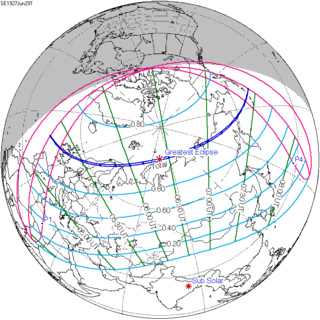Solar eclipse of June 29, 1927
| Solar eclipse of June 29, 1927 | |
|---|---|
| Type of eclipse | |
| Nature | Total |
| Gamma | 0.8163 |
| Magnitude | 1.0128 |
| Maximum eclipse | |
| Duration | 50 s (0 min 50 s) |
| Coordinates | 78°06′N 73°48′E / 78.1°N 73.8°E |
| Max. width of band | 77 km (48 mi) |
| Times (UTC) | |
| Greatest eclipse | 6:23:27 |
| References | |
| Saros | 145 (17 of 77) |
| Catalog # (SE5000) | 9344 |
A total solar eclipse occurred at the Moon's ascending node of orbit between Tuesday, June 28 and Wednesday, June 29, 1927,[1] with a magnitude of 1.0128. A solar eclipse occurs when the Moon passes between Earth and the Sun, thereby totally or partly obscuring the image of the Sun for a viewer on Earth. A total solar eclipse occurs when the Moon's apparent diameter is larger than the Sun's, blocking all direct sunlight, turning day into darkness. Totality occurs in a narrow path across Earth's surface, with the partial solar eclipse visible over a surrounding region thousands of kilometres wide. Occurring about 20 hours after perigee (on June 28, 1927, at 10:40 UTC), the Moon's apparent diameter was larger.[2]
The path of totality crossed far northern Europe and Asia, including the United Kingdom, Norway, Sweden, Finland and Soviet Union (today's Russia) on June 29 (Wednesday), and finally passed Amukta in Alaska on June 28 (Tuesday). A partial eclipse was visible for parts of Europe, North Africa, North Asia, and northern North America.
Observation in England
[edit]This was the first total eclipse visible from British mainland soil for 203 years. The Astronomer Royal set up a camp to observe the eclipse from the grounds of Giggleswick School in North Yorkshire, which was on the line of totality.[3][4] An observer at Southport, where an estimated quarter of a million people were on the shore to watch, described the eclipse for the Journal of the Royal Astronomical Society of Canada, describing it as "those memorable 23 seconds ... a landmark forever in the lives of those privileged to see for the first time the Sun's Corona, whose secrets are only revealed to us for some few minutes in each century."[5]
This eclipse is referenced in the closing pages of Dorothy L. Sayers' novel Unnatural Death.[6] Frances Brody's 2017 novel Death in the Stars is set at Giggleswick School while crowds were there to view the eclipse.[7]
Virginia Woolf recorded her impression of the eclipse, including the words "We had fallen. It was extinct. There was no colour. The earth was dead."[8]
Eclipse details
[edit]Shown below are two tables displaying details about this particular solar eclipse. The first table outlines times at which the moon's penumbra or umbra attains the specific parameter, and the second table describes various other parameters pertaining to this eclipse.[9]
| Event | Time (UTC) |
|---|---|
| First Penumbral External Contact | 1927 June 29 at 04:00:07.6 UTC |
| First Umbral External Contact | 1927 June 29 at 05:20:27.1 UTC |
| First Central Line | 1927 June 29 at 05:20:38.0 UTC |
| First Umbral Internal Contact | 1927 June 29 at 05:20:49.1 UTC |
| Greatest Duration | 1927 June 29 at 06:21:22.6 UTC |
| Greatest Eclipse | 1927 June 29 at 06:23:27.1 UTC |
| Equatorial Conjunction | 1927 June 29 at 06:27:51.0 UTC |
| Ecliptic Conjunction | 1927 June 29 at 06:32:16.1 UTC |
| Last Umbral Internal Contact | 1927 June 29 at 07:26:05.2 UTC |
| Last Central Line | 1927 June 29 at 07:26:13.4 UTC |
| Last Umbral External Contact | 1927 June 29 at 07:26:21.6 UTC |
| Last Penumbral External Contact | 1927 June 29 at 08:46:50.3 UTC |
| Parameter | Value |
|---|---|
| Eclipse Magnitude | 1.01277 |
| Eclipse Obscuration | 1.02570 |
| Gamma | 0.81630 |
| Sun Right Ascension | 06h28m24.1s |
| Sun Declination | +23°17'17.5" |
| Sun Semi-Diameter | 15'43.9" |
| Sun Equatorial Horizontal Parallax | 08.6" |
| Moon Right Ascension | 06h28m13.9s |
| Moon Declination | +24°04'25.1" |
| Moon Semi-Diameter | 15'47.4" |
| Moon Equatorial Horizontal Parallax | 0°57'56.9" |
| ΔT | 24.4 s |
Eclipse season
[edit]This eclipse is part of an eclipse season, a period, roughly every six months, when eclipses occur. Only two (or occasionally three) eclipse seasons occur each year, and each season lasts about 35 days and repeats just short of six months (173 days) later; thus two full eclipse seasons always occur each year. Either two or three eclipses happen each eclipse season. In the sequence below, each eclipse is separated by a fortnight.
| June 15 Descending node (full moon) |
June 29 Ascending node (new moon) |
|---|---|
 |

|
| Total lunar eclipse Lunar Saros 119 |
Total solar eclipse Solar Saros 145 |
Related eclipses
[edit]Eclipses in 1927
[edit]- An annular solar eclipse on January 3.
- A total lunar eclipse on June 15.
- A total solar eclipse on June 29.
- A total lunar eclipse on December 8.
- A partial solar eclipse on December 24.
Metonic
[edit]- Preceded by: Solar eclipse of September 10, 1923
- Followed by: Solar eclipse of April 18, 1931
Tzolkinex
[edit]- Preceded by: Solar eclipse of May 18, 1920
- Followed by: Solar eclipse of August 10, 1934
Half-Saros
[edit]- Preceded by: Lunar eclipse of June 24, 1918
- Followed by: Lunar eclipse of July 4, 1936
Tritos
[edit]- Preceded by: Solar eclipse of July 30, 1916
- Followed by: Solar eclipse of May 29, 1938
Solar Saros 145
[edit]- Preceded by: Solar eclipse of June 17, 1909
- Followed by: Solar eclipse of July 9, 1945
Inex
[edit]- Preceded by: Solar eclipse of July 18, 1898
- Followed by: Solar eclipse of June 8, 1956
Triad
[edit]- Preceded by: Solar eclipse of August 27, 1840
- Followed by: Solar eclipse of April 29, 2014
Solar eclipses of 1924–1928
[edit]This eclipse is a member of a semester series. An eclipse in a semester series of solar eclipses repeats approximately every 177 days and 4 hours (a semester) at alternating nodes of the Moon's orbit.[10]
The partial solar eclipses on March 5, 1924 and August 30, 1924 occur in the previous lunar year eclipse set, and the solar eclipses on May 19, 1928 and November 12, 1928 occur in the next lunar year eclipse set.
| Solar eclipse series sets from 1924 to 1928 | ||||||
|---|---|---|---|---|---|---|
| Ascending node | Descending node | |||||
| Saros | Map | Gamma | Saros | Map | Gamma | |
| 115 | July 31, 1924 Partial |
−1.4459 | 120 | January 24, 1925 Total |
0.8661 | |
| 125 | July 20, 1925 Annular |
−0.7193 | 130 Totality in Sumatra, Indonesia |
January 14, 1926 Total |
0.1973 | |
| 135 | July 9, 1926 Annular |
0.0538 | 140 | January 3, 1927 Annular |
−0.4956 | |
| 145 | June 29, 1927 Total |
0.8163 | 150 | December 24, 1927 Partial |
−1.2416 | |
| 155 | June 17, 1928 Partial |
1.5107 | ||||
Saros 145
[edit]This eclipse is a part of Saros series 145, repeating every 18 years, 11 days, and containing 77 events. The series started with a partial solar eclipse on January 4, 1639. It contains an annular eclipse on June 6, 1891; a hybrid eclipse on June 17, 1909; and total eclipses from June 29, 1927 through September 9, 2648. The series ends at member 77 as a partial eclipse on April 17, 3009. Its eclipses are tabulated in three columns; every third eclipse in the same column is one exeligmos apart, so they all cast shadows over approximately the same parts of the Earth.
The longest duration of annularity was produced by member 15 at 6 seconds (by default) on June 6, 1891, and the longest duration of totality will be produced by member 50 at 7 minutes, 12 seconds on June 25, 2522. All eclipses in this series occur at the Moon’s ascending node of orbit.[11]
| Series members 10–32 occur between 1801 and 2200: | ||
|---|---|---|
| 10 | 11 | 12 |
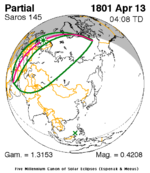 April 13, 1801 |
 April 24, 1819 |
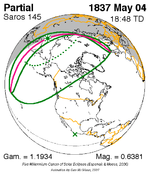 May 4, 1837 |
| 13 | 14 | 15 |
 May 16, 1855 |
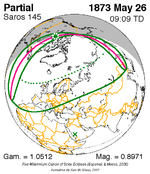 May 26, 1873 |
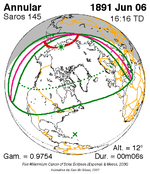 June 6, 1891 |
| 16 | 17 | 18 |
 June 17, 1909 |
 June 29, 1927 |
 July 9, 1945 |
| 19 | 20 | 21 |
 July 20, 1963 |
 July 31, 1981 |
 August 11, 1999 |
| 22 | 23 | 24 |
 August 21, 2017 |
 September 2, 2035 |
 September 12, 2053 |
| 25 | 26 | 27 |
 September 23, 2071 |
 October 4, 2089 |
 October 16, 2107 |
| 28 | 29 | 30 |
 October 26, 2125 |
 November 7, 2143 |
 November 17, 2161 |
| 31 | 32 | |
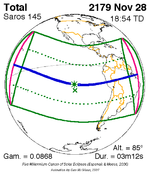 November 28, 2179 |
 December 9, 2197 | |
Metonic series
[edit]The metonic series repeats eclipses every 19 years (6939.69 days), lasting about 5 cycles. Eclipses occur in nearly the same calendar date. In addition, the octon subseries repeats 1/5 of that or every 3.8 years (1387.94 days). All eclipses in this table occur at the Moon's ascending node.
| 23 eclipse events between February 3, 1859 and June 29, 1946 | ||||
|---|---|---|---|---|
| February 1–3 | November 21–22 | September 8–10 | June 28–29 | April 16–18 |
| 109 | 111 | 113 | 115 | 117 |
 February 3, 1859 |
 November 21, 1862 |
 June 28, 1870 |
 April 16, 1874 | |
| 119 | 121 | 123 | 125 | 127 |
 February 2, 1878 |
 November 21, 1881 |
 September 8, 1885 |
 June 28, 1889 |
 April 16, 1893 |
| 129 | 131 | 133 | 135 | 137 |
 February 1, 1897 |
 November 22, 1900 |
 September 9, 1904 |
 June 28, 1908 |
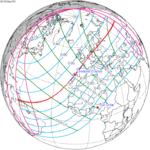 April 17, 1912 |
| 139 | 141 | 143 | 145 | 147 |
 February 3, 1916 |
 November 22, 1919 |
 September 10, 1923 |
 June 29, 1927 |
 April 18, 1931 |
| 149 | 151 | 153 | 155 | |
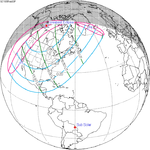 February 3, 1935 |
 November 21, 1938 |
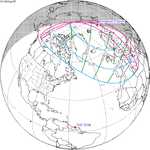 September 10, 1942 |
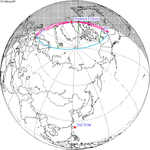 June 29, 1946 | |
Tritos series
[edit]This eclipse is a part of a tritos cycle, repeating at alternating nodes every 135 synodic months (≈ 3986.63 days, or 11 years minus 1 month). Their appearance and longitude are irregular due to a lack of synchronization with the anomalistic month (period of perigee), but groupings of 3 tritos cycles (≈ 33 years minus 3 months) come close (≈ 434.044 anomalistic months), so eclipses are similar in these groupings.
The partial solar eclipses on November 16, 2134 (part of Saros 164) and October 16, 2145 (part of Saros 165) are also a part of this series but are not included in the table below.
| Series members between 1801 and 2069 | ||||
|---|---|---|---|---|
 June 6, 1807 (Saros 134) |
 May 5, 1818 (Saros 135) |
 April 3, 1829 (Saros 136) |
 March 4, 1840 (Saros 137) |
 February 1, 1851 (Saros 138) |
 December 31, 1861 (Saros 139) |
 November 30, 1872 (Saros 140) |
 October 30, 1883 (Saros 141) |
 September 29, 1894 (Saros 142) |
 August 30, 1905 (Saros 143) |
 July 30, 1916 (Saros 144) |
 June 29, 1927 (Saros 145) |
 May 29, 1938 (Saros 146) |
 April 28, 1949 (Saros 147) |
 March 27, 1960 (Saros 148) |
 February 25, 1971 (Saros 149) |
 January 25, 1982 (Saros 150) |
 December 24, 1992 (Saros 151) |
 November 23, 2003 (Saros 152) |
 October 23, 2014 (Saros 153) |
 September 21, 2025 (Saros 154) |
 August 21, 2036 (Saros 155) |
 July 22, 2047 (Saros 156) |
 June 21, 2058 (Saros 157) |
 May 20, 2069 (Saros 158) |
Inex series
[edit]This eclipse is a part of the long period inex cycle, repeating at alternating nodes, every 358 synodic months (≈ 10,571.95 days, or 29 years minus 20 days). Their appearance and longitude are irregular due to a lack of synchronization with the anomalistic month (period of perigee). However, groupings of 3 inex cycles (≈ 87 years minus 2 months) comes close (≈ 1,151.02 anomalistic months), so eclipses are similar in these groupings.
| Series members between 1801 and 2200 | ||
|---|---|---|
 September 17, 1811 (Saros 141) |
 August 27, 1840 (Saros 142) |
 August 7, 1869 (Saros 143) |
 July 18, 1898 (Saros 144) |
 June 29, 1927 (Saros 145) |
 June 8, 1956 (Saros 146) |
 May 19, 1985 (Saros 147) |
 April 29, 2014 (Saros 148) |
 April 9, 2043 (Saros 149) |
 March 19, 2072 (Saros 150) |
 February 28, 2101 (Saros 151) |
 February 8, 2130 (Saros 152) |
 January 19, 2159 (Saros 153) |
 December 29, 2187 (Saros 154) |
|
See also
[edit]References
[edit]- ^ "June 29, 1927 Total Solar Eclipse". timeanddate. Retrieved 3 August 2024.
- ^ "Moon Distances for London, United Kingdom, England". timeanddate. Retrieved 3 August 2024.
- ^ "With the Astronomer Royal". The Guardian. 30 June 1927. Retrieved 9 January 2023.
- ^ "Eclipse archive". news.bbc.co.uk. BBC News. 17 August 1999. Retrieved 9 January 2023.
- ^ Seeley, Sylvia (1927). "The total eclipse of June 29, 1927 as seen by a spectator at Southport, England". Journal of the Royal Astronomical Society of Canada. 21: 328-332. Bibcode:1927JRASC..21..328S. Retrieved 9 January 2023 – via SAO/NASA Astrophysics Data System (ADS).
- ^ "Unnatural Death".
- ^ "Death in the Stars: the ninth Kate Shackleton mystery by Frances Brody". frances-brody.com. Retrieved 9 January 2023.
- ^ Popova, Maria (9 May 2018). "Darkness in the Celestial Lighthouse: Virginia Woolf's Arresting 1927 Account of a Total Solar Eclipse". The Marginalian. Retrieved 9 January 2023.
- ^ "Total Solar Eclipse of 1927 Jun 29". EclipseWise.com. Retrieved 3 August 2024.
- ^ van Gent, R.H. "Solar- and Lunar-Eclipse Predictions from Antiquity to the Present". A Catalogue of Eclipse Cycles. Utrecht University. Retrieved 6 October 2018.
- ^ "NASA - Catalog of Solar Eclipses of Saros 145". eclipse.gsfc.nasa.gov.
Sources
[edit]- Earth visibility chart and eclipse statistics Eclipse Predictions by Fred Espenak, NASA/GSFC
- Fotos of Solar Corona June 29, 1927
- Russia expedition for solar eclipse of June 29, 1927
External links
[edit]- Recording the eclipse video of the Astronomer Royal's preparations, from Pathé News

